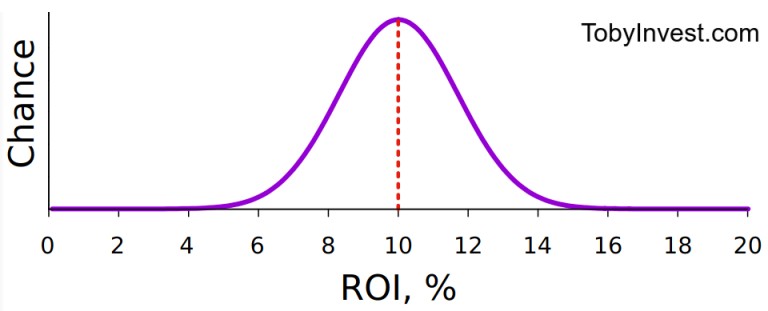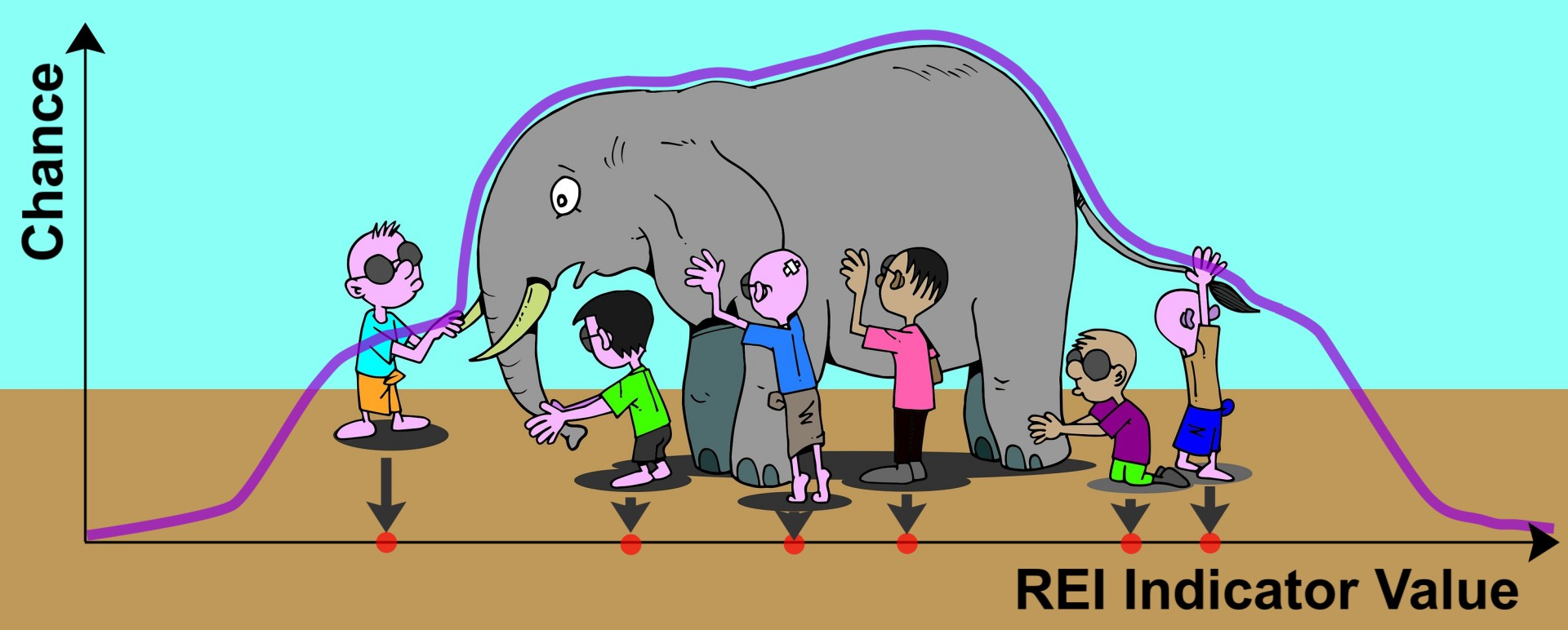Quantum Scenario Modeling of REI

Both weather forecasters and classical analysts create a single forecast. In contrast, the quantum analyst models billions of scenarios under which a real estate investment can evolve.
Difficulty: medium. 9 min read.
Table of Contents
Forecasting vs Scenario Modeling
Definitions
Use the definitions from "Scenario Modeling: What You Need to Know" article at Synario.com:
Scenario modeling examines a range of potential futures, instead of attempting to predict just one future. While you don't have structured data on future performance, like you do with the past, you can use inputs and scenarios to see possible trends that you may encounter in the next few years or decades.
Scenario modeling differs from classical forecasting because:
- Classical forecasting analyzes the undertaking of specific projects to identify the ‘best-case’ scenario or ‘most likely’ future. You predict the impact of executing a plan versus not executing a plan
- Scenario modeling doesn’t just look at the ‘best-case’ scenario or ‘most likely’ future. Rather, you produce a multitude of possible futures and compare them to each other.
There are two main approaches to REI scenario modeling - classical forecasting and quantum scenario modeling.
Classical forecasting
Classical forecasting of real estate investment explores a limited number of forecasts in which an investment can go, or no forecast at all.
The main types of classical forecasting:
"No Forecast." First-time investors don't understand the concept of forecasting. They run an investment calculator or a spreadsheet and believes sacredly that the investment will behave strictly as the result of the calculations.
"One Forecast." Little-experienced investors already understand that an investment can develop in any ways. They consciously choose the one forecast that best suits their goals and make an analysis of it. For example:
- A "conservative case" forecast for investor-buyers
- A "neutral case" forecast for investment calculator services
- An "optimistic case" forecast for wholesalers.
"Two Forecasts." Two forecasts are popular with repairmen and agents. They can't forecast the exact price of a renovation or a real estate property. Repairmen and agents often prefer to forecast a "price range" - 2 values between which the real value of the price is likely to be in the future.
"Three Forecasts." Advanced real estate analysts provide a separate analysis for each of the three typical forecasts:
- A “worst case”
- A “neutral case”
- A “best case”
Quantum scenario modeling
Quantum scenario modeling runs multiple investment scenarios and compares them with each other.
"Billions of Scenarios." Quantum analysts model all the scenarios in which a real estate investment can proceed. These are billions and billions of scenarios. After lengthy quantum calculations, each investment indicator gets a quantum plot. The plot compares the occurrence chances of all possible values of the indicator:

KPI sets
A real estate Key Performance Indicator (KPI) or metric is a quantifiable measure used to assess the performance of a business in the real estate investment. A KPI set is used to analyze the real estate investment. For example:
- Net Operating Income
- Capitalization Rate
- Internal Rate of Return
- Cash Flow
- Cash on Cash Return
- ...
Each type of REI analysis has its own KPI set.
Let's look at three popular KPI sets used in real estate investing (as they become more advanced):
- Price per square foot analysis (PPSF)
- Income capitalization (Income)
- The discounted cash flow (DCF)
Let's look at five more methods of the forecasting/modeling (as they become more advanced):
- "No forecast"
- "One forecast"
- "Two forecast"
- "Three forecast"
- Quantum "billions of scenarios"
Either method of forecasting/modeling can be applied to any set of KPIs. But usually simple sets of KPIs use simply forecasting. More complex sets use complex forecasting or modeling:
| Number of | |||||
| KPI sets: | Forecasts: | Scenarios: | |||
| 0 | 1 | 2 | 3 | billions | |
| PPSF | ✔ | ✔ | |||
| Income | ✔ | ✔ | ✔ | ✔ | |
| DCF | ✔ | ✔ | |||
So:
- Classical analysis of REI means preparing several forecasts (red cells) based on one of the sets of REI KPIs (blue cells)
- Quantum analysis of REI is to prepare and compare billions of scenarios (green cells) based on one set of REI KPIs (blue cells).
Note that the classical and quantitative analyses of REI use exactly the same sets of KPIs (blue cells). The only difference is the careful modeling of the scenarios and the attempt to compare them:
- Classical analysis purely symbolically makes several forecasts (or has no concept of forecasts at all) and does not compare them to each other
- Quantum analysis carefully examines all investment scenarios in order to compare them with each other later.
Quantum analysis methods
There is a tradition in science of naming methods that use quantum approach. If we use quantum modeling for some set of REI KPIs, we must add the word Quantum or the letter Q before the name of the set. This is how the quantum versions of the REI KPIs are named:
- Quantum development analysis
- Quantum operations analysis
- Quantum disposition analysis
- Quantum income capitalization
- Quantum DCF (the discounted cash flow)
- ...
The collection of these versions is called quantum analysis of real estate investment.
Let's take a closer look at how quantum modeling works for REI KPI sets:
Quantum repairs/operations/disposition analysis
Prices for the building materials are constantly changing. Before you start a repair, it's impossible to specify the exact amount of time and money that will be needed for the repair. Quantum modeling creates quantum graphs of the time and money spent on repair, taking into account all possible scenarios.
Similarly, quantum modeling can be used for operations/disposition costs and price forecasting.
Quantum income capitalization
Classical income capitalization analysis is supposed to provide the single best forecast. We have to use a lot of assumptions and simplifications. They make the classical analysis of income capitalization wrong. Quantum modeling is not tied to finding the single best scenario. It finds all scenarios and compares them to each other. Quantum income capitalization is free of the errors of classical income capitalization.
However, Quantum income capitalization is difficult to popularize. Investors often do not see the need to simulate many scenarios and are satisfied with a single forecast of classical income capitalization.
Quantum DCF
Quantum modeling is most in demand for more advanced investment analysis methods. Investors using advanced methods are well aware of the need to develop at least a few forecasts. They welcome with enthusiasm the quantum idea of modeling absolutely all scenarios under which an investment can go.
If we apply quantum scenario modeling to DCF (the discounted cash flow), we get Quantum DCF, abbreviated QDCF.
Quantum DCF uses an advanced DCF KPI set. Only billions of scenarios are simulated instead of 3 forecasts. This allows replacing all output indicator values with quantum plots.
Investors who perfectly familiar with the classical DCF understand a "bad case," "neutral case," and "good case" scenario. They quickly begin to read the forms of quantum plots.
Unscientific nature of classical analysis
Classical REI analysis is an unscientific method (oooh, oh my god, oh my god, can't believe I’m writing this!). But it is.
Non-reproducibility
Investors have every reason not to trust the classic real estate analyses that other analysts have done. The distrust is getting to the point where many REI marketplaces do not allow REI analysis to be attached to investment properties that are listed.
The reason for the distrust is that classical analysis of real estate investment is not reproducible.
Wikipedia says about reproducibility:
Reproducibility is a major principle underpinning the scientific method. Results obtained in a statistical analysis of a data set should be achieved again with a high degree of reliability when repeated by different researchers using the same methodology. Only after many such successful replications can a result be recognized as scientific knowledge.
Classical analysis allows you to specify one scenario that best characterizes an investment. The hardest thing of all is to find the best scenario among billions, especially if you don't model them all. A blind search among billions of scenarios produces random results. Different analysts produce different classical analyses for the same property and the same KPI set. Reproducibility of results in classic REI analysis is out of the question. This introduces a large amount of randomness into classic real estate analysis.
Blind men and an elephant
It's relevant to remember the old parable.
Wikipedia says about "Blind men and an elephant":
The parable of the blind men and an elephant originated in the ancient Indian subcontinent. It is a story of a group of blind men who have never come across an elephant before and who learn and imagine what the elephant is like by touching it. Each blind man feels a different part of the elephant's body, but only one part, such as the side or the tusk. They then describe the elephant based on their limited experience and their descriptions of the elephant are different from each other:

The moral of the parable is that humans have a tendency to claim absolute truth based on their limited, subjective experience as they ignore other people's limited, subjective experiences which may be equally true.
Grope of quantum elephant
Classical analysis limits analysts to only one attempt at modeling. They can grope the quantum plot of the indicator on the indicator value axis only once. Classical analysis believes that one value is enough to characterize the quantum plot. Different analysts grope the quantum plot in different places and get different forecasts:

Choosing a single point on the indicator value axis and arguing whose point is chosen correctly is an obvious result of trying to form an opinion about the quantum graph through the random choice of a single point. Advanced classical analysts try to work around the limitation and look for three points - a "worst case," "neutral case," and "best case." If the property is expensive, the investor can still ask to do a classical analysis of two different analysts, each of whom will indicate 3 scenarios on the value axis of the quantum plot.
All forecasts can happen during the lifetime of an investment. And all forecasts say nothing about the quantum plot, either individually or together.
Quantum analysis as a standard
Quantum versions of real estate analysis (Quantum income capitalization, Quantum DCF,...) may be the universally accepted standard of REI analysis.
1) Reproducibility. Quantum modeling is well reproducible. Different quantum analysts model the same set of scenarios for the same real estate - "all scenarios". Quantum plots from different quantum analysts have a similar form. Medians of similar quantum plots are necessarily in the same place, too.
2) Full control. Quantum analysis is based on full modeling of all scenarios of investment evolution. Potential defects in the original data are well detected through the forms of quantum plots.
3) Sales boost. Quantum analysis applied to investment properties dramatically increases buyer interest. Investor-buyers no longer take the time to prepare a verifying classical analysis. Quantum analysis from a "stranger" certified quantum analyst is enough to make an informed decision about buying interest.
